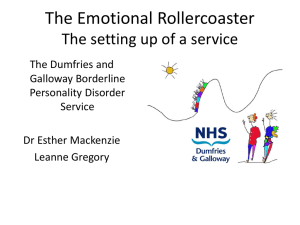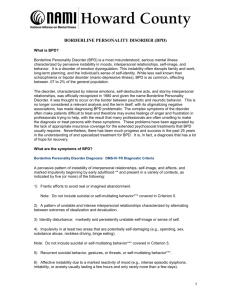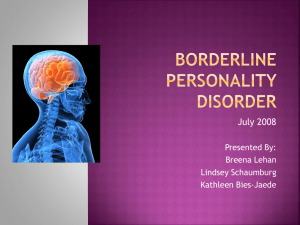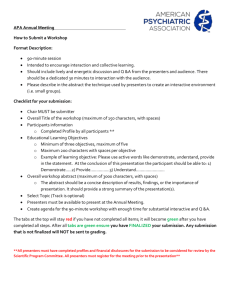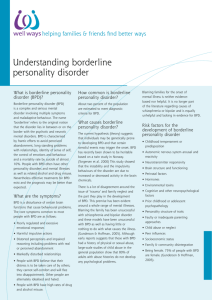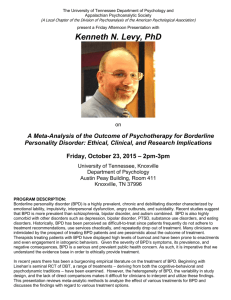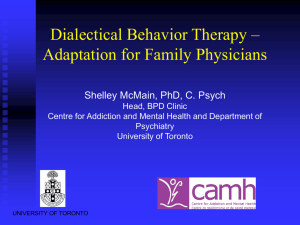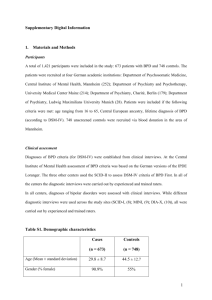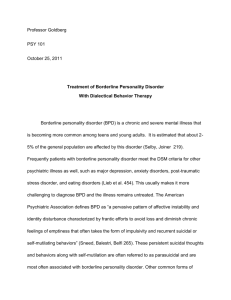A personality disorder is an enduring pattern of inner experience
advertisement
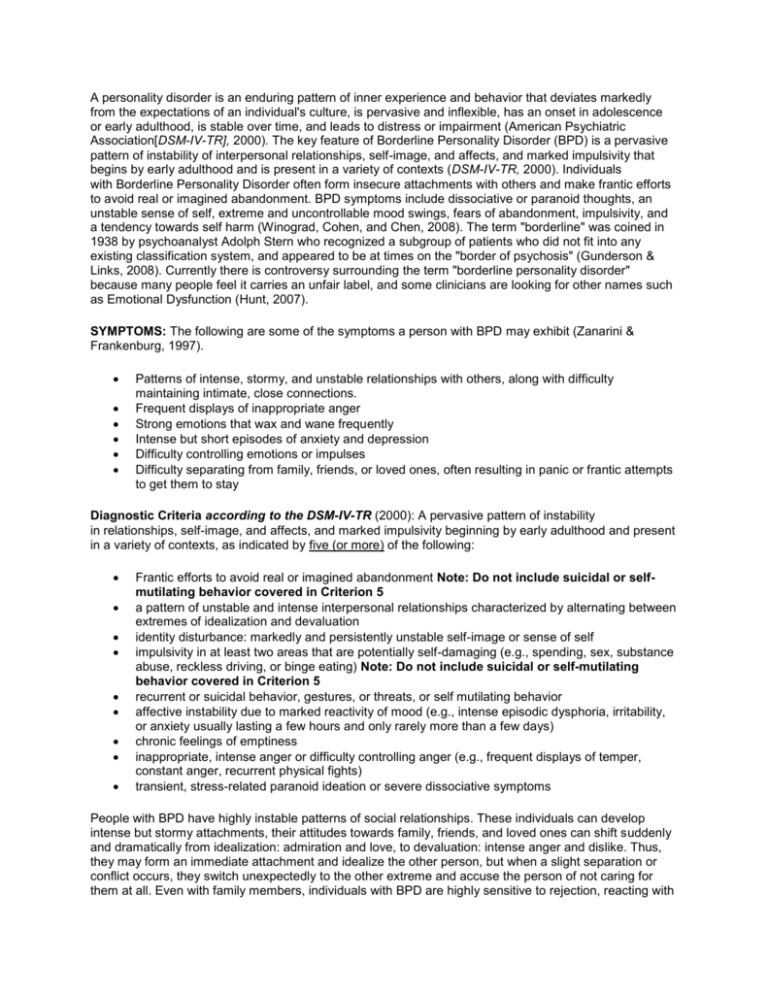
A personality disorder is an enduring pattern of inner experience and behavior that deviates markedly from the expectations of an individual's culture, is pervasive and inflexible, has an onset in adolescence or early adulthood, is stable over time, and leads to distress or impairment (American Psychiatric Association[DSM-IV-TR], 2000). The key feature of Borderline Personality Disorder (BPD) is a pervasive pattern of instability of interpersonal relationships, self-image, and affects, and marked impulsivity that begins by early adulthood and is present in a variety of contexts (DSM-IV-TR, 2000). Individuals with Borderline Personality Disorder often form insecure attachments with others and make frantic efforts to avoid real or imagined abandonment. BPD symptoms include dissociative or paranoid thoughts, an unstable sense of self, extreme and uncontrollable mood swings, fears of abandonment, impulsivity, and a tendency towards self harm (Winograd, Cohen, and Chen, 2008). The term "borderline" was coined in 1938 by psychoanalyst Adolph Stern who recognized a subgroup of patients who did not fit into any existing classification system, and appeared to be at times on the "border of psychosis" (Gunderson & Links, 2008). Currently there is controversy surrounding the term "borderline personality disorder" because many people feel it carries an unfair label, and some clinicians are looking for other names such as Emotional Dysfunction (Hunt, 2007). SYMPTOMS: The following are some of the symptoms a person with BPD may exhibit (Zanarini & Frankenburg, 1997). Patterns of intense, stormy, and unstable relationships with others, along with difficulty maintaining intimate, close connections. Frequent displays of inappropriate anger Strong emotions that wax and wane frequently Intense but short episodes of anxiety and depression Difficulty controlling emotions or impulses Difficulty separating from family, friends, or loved ones, often resulting in panic or frantic attempts to get them to stay Diagnostic Criteria according to the DSM-IV-TR (2000): A pervasive pattern of instability in relationships, self-image, and affects, and marked impulsivity beginning by early adulthood and present in a variety of contexts, as indicated by five (or more) of the following: Frantic efforts to avoid real or imagined abandonment Note: Do not include suicidal or selfmutilating behavior covered in Criterion 5 a pattern of unstable and intense interpersonal relationships characterized by alternating between extremes of idealization and devaluation identity disturbance: markedly and persistently unstable self-image or sense of self impulsivity in at least two areas that are potentially self-damaging (e.g., spending, sex, substance abuse, reckless driving, or binge eating) Note: Do not include suicidal or self-mutilating behavior covered in Criterion 5 recurrent or suicidal behavior, gestures, or threats, or self mutilating behavior affective instability due to marked reactivity of mood (e.g., intense episodic dysphoria, irritability, or anxiety usually lasting a few hours and only rarely more than a few days) chronic feelings of emptiness inappropriate, intense anger or difficulty controlling anger (e.g., frequent displays of temper, constant anger, recurrent physical fights) transient, stress-related paranoid ideation or severe dissociative symptoms People with BPD have highly instable patterns of social relationships. These individuals can develop intense but stormy attachments, their attitudes towards family, friends, and loved ones can shift suddenly and dramatically from idealization: admiration and love, to devaluation: intense anger and dislike. Thus, they may form an immediate attachment and idealize the other person, but when a slight separation or conflict occurs, they switch unexpectedly to the other extreme and accuse the person of not caring for them at all. Even with family members, individuals with BPD are highly sensitive to rejection, reacting with anger and distress to such mild separations as vacations, business trips, or a sudden change in plans. These fears of abandonment seem to be related to difficulties feeling emotionally connected to important persons when they are physically absent, leaving the individual with BPD feeling lost and perhaps worthless (Zanarini & Frankenburg, 1997). Individuals with Borderline Personality Disorder are very sensitive to environmental circumstances, and may experience intense abandonment fears and inappropriate anger even when faced with a realistic time-limited separation or when there are unavoidable changes in plans. People with BPD may believe that this "abandonment" implies that they are "bad". Frantic efforts to avoid abandonment may include impulsive actions such as self-mutilating or suicidal behaviors (DSM-IV-TR, 2000). Often these are attempts to get people to stay with them, especially loved ones or caregivers. A linkage has been established between BPD and impulse-control disorders (Martin & Volkmar 2007). Individuals with BPD display impulsivity in ways that are potentially self-damaging. They may gamble, spend money irresponsibly, binge eat, abuse substances, engage in unsafe sex, or drive recklessly (DSM-IV-TR, 2000). These self-destructive acts are usually precipitated by threats of separation or rejection or by expectations that they assume increased responsibility. Self-mutilation may occur during dissociative experiences and often brings relief by affirming the ability to feel or by expiating the individual's sense of being evil (DSM-IV-TR, 2000). There may be an identity disturbance characterized by markedly and persistently unstable self-image or sense of self. There are sudden and dramatic shifts in self-image, characterized by shifting goals, values, and vocational aspirations. Individuals with BPD may display sudden changes in opinions and plans about career, sexual identity, values and types of friends. These individuals may suddenly change from a needy supplicant for help to a righteous avenger of past mistreatment. Such experiences usually occur in situations in which the individual feels a lack of a meaningful relationship, nurturing, and support. People with BPD often undermine themselves and their abilities (DSM-IV-TR, 2000). Some psychoanalytic theorists have hypothesized that disruptions in early relationships, along with problems in the separation-individuation process are key factors in the etiology of BPD, and theorize that the consequence is responding to separations and stress by relying on "transitional objects" such as drugs, food, or sex to provide soothing and comfort; and angry, manipulative efforts to force involvement and attention from others (Martin & Volkmar, 2007). PREVELANCE: Borderline Personality Disorder is diagnosed more frequently than any other personality disorder (Gunderson & Links, 2008).The prevalence of BPD is estimated to be about 2% of the general population, about 10% among individuals seen in outpatient mental health clinics, and about 20% among psychiatric inpatients. It ranges from 30% to 60% among clinical populations with personality disorders. BPD is diagnosed predominantly (about 75%) in females (DSM-IV-TR, 2000). Recurrent suicidality is often the reason most people with BPD present for help. Completed suicide occurs in 8%-10% of individuals diagnosed with BPD (DSM-IV-TR, 2000). ETIOLOGY: A large body of research into psychological predictors of BPD has suggested a range of adverse and traumatic childhood experiences as etiological factors, though this calls for careful interpretation as most of the studies have been retrospective in nature (Martin & Volkmar, 2007). BPD is about five times more common among first-degree biological relatives of those with the disorder than in the general population (DSM-IV-TR, 2000). Some researchers propose that at least a subgroup of patients with BPD have a vulnerability to affective dysregulation, which gives rise to mood lability and heightened sensitivity to rejection and abandonment (Martin & Volkmar, 2007). Often times individuals with the disorder have experienced some form of childhood trauma such as physical or sexual abuse. (Zanarini & Frankenburg, 1997). A new model proposes that BPD is biological, neurological and genetic, caused by a dysfunction of the limbic area of the brain, which controls emotion. The etiology of BPD can best be described as having biological, neurological, and genetic factors, combined with childhood trauma, abuse or neglect that leads to dysregulated emotions, distorted cognitions, social skill deficits, and few adaptive coping strategies (Hunt, 2007). TREATMENT: Treatment options for BPD include pharmacotherapy (especially mood stabilizers, SSRI's and atypical antipsychotics) and psychotherapeutic interventions that focus on distress tolerance, affective regulation, changing distorted beliefs, and introducing new social and relationship problem solving skills. Psychotherapy which allows the patient to talk about present difficulties and past experiences in the presence of an empathetic, accepting and non-judgmental therapist has proven to be effective (Hunt, 2007). The goals of treatment could include increased self-awareness with greater impulse control and increased stability of relationships. Therapy should help to alleviate psychotic or mood disturbance symptoms and generally integrate the whole personality (Winograd & Chen, 2008). People working or caring for individuals with BPD need to be empowered to set appropriate limits on problematic behavior while maintaining empathy and validating the painful affect often experienced (Hunt, 2007). Although the tendency towards intense emotions, impulsivity, and intensity in relationships is often lifelong, individuals who engage in therapeutic intervention often show improvement during the first year (DSM-IV-TR, 2000). References: American Psychiatric Association (2000). Diagnostic and statistical manual of mental disorders (4th ed. text revision). Washington, DC: Author. Gunderson, J. G. & Links, P.S. (2008). Borderline personality disorder: a clinical guide (2nd ed.). Arlington, VA: American Psychiatric Publishing, Inc. Hunt, M. (2007). Borderline personality disorder across the lifespan. Journal of Women and Aging, 19(1-2), 173-191. Martin, A. & Volkmar, F. R. (2007). Lewis's child and adolescent psychiatry a comprehensive textbook (4th ed.). Philadelphia, PA: Lippincott Williams & Wilkins Wingorad, G., Cohen, P., & Chen, H. (2008). Adolescent borderline symptoms in the community: prognosis for functioning over 20 years. Journal of Child Psychology and Psychiatry, 49(9), 930-941. Zanarini, M.C., & Frankenburg, F. R. 1997). Pathways to the development of borderline personality disorder. Journal of Personality Disorders, 11(1), 93-104.
